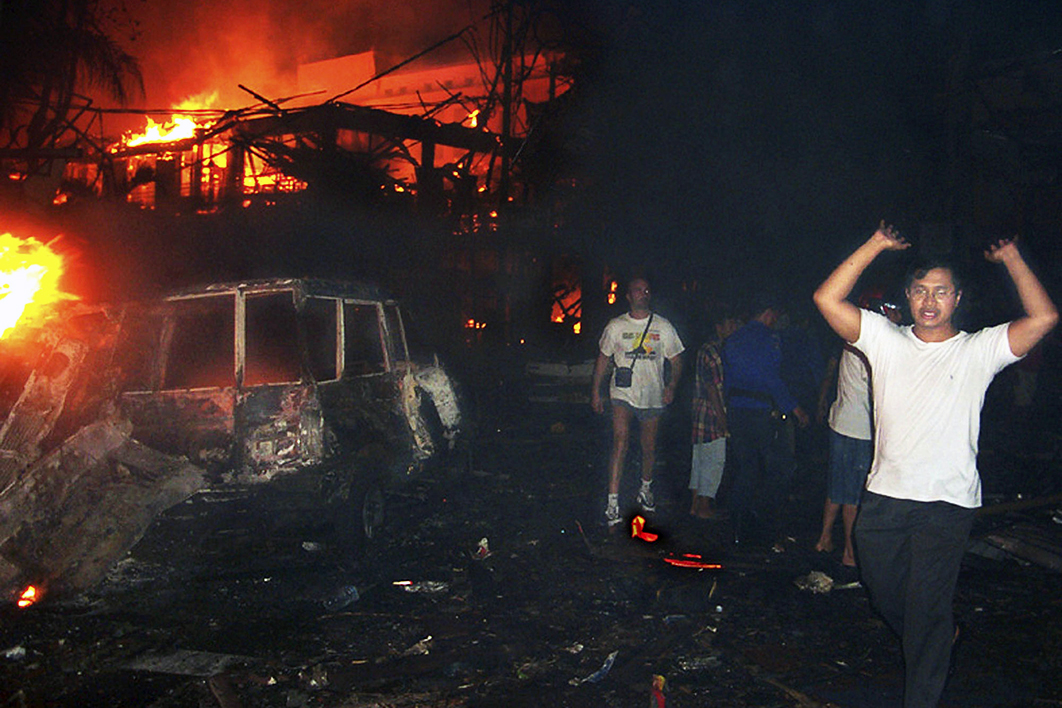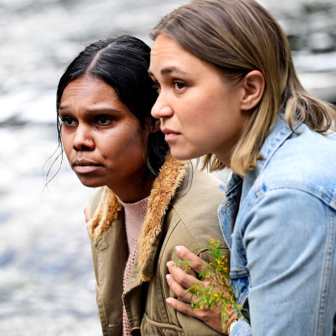In the end, it was a pair of shoes that defined the horror of the moment. They were a stylish black pair with suede straps and high heels: shoes for partying, special shoes kept for a night out on the town after a lazy Saturday at the beach. Now they poked out from beneath a bloodstained sheet.
The young woman’s body lay on an open tiled platform in the yard of Bali’s Sanglah hospital surrounded by piles of other corpses, many charred beyond recognition. A medical team in gumboots and rubber gloves moved slowly through, checking teeth and scraps of clothing that might help identify the victims. Scores more bodies filled the entrance foyer of the hospital and lined the walkways to wards crowded with the injured. Flies were swarming in the oppressive evening heat.
Ambulances weaved through the traffic, ferrying the most seriously injured to evacuation flights. Pickup trucks unloaded dozens of crude plywood coffins. The dead and wounded were mostly young, mostly Australian — many kids on their first trip to Bali.
I had woken in Singapore on the morning of 13 October 2002 to the shocking news of the massive bomb blasts that had destroyed the popular Sari Club and the neighbouring Paddy’s Bar in the heart of Kuta’s nightlife district. Within hours, I was reporting from the midst of the chaos.
The Bali bombings would soon be confirmed as the worst act of terrorism in Australian history. The ultimate toll would be 202 dead — eighty-eight of them Australians — and hundreds more seriously injured, many of them Australians.
As shocking as the moment was, it should not have come as the surprise it did to most Australians. A year earlier, the world had been numbed by the attack on the World Trade Center towers in New York. It was clear that al Qaeda and its global affiliates had the means and the determination to continue striking their Western enemies at will — and anywhere.
Moments before the first suicide bomber walked into Paddy’s Bar just after 11pm on Saturday 12 October and, seconds later, another detonated a massive car bomb in front of the Sari Club, a smaller bomb — crude calling card of al Qaeda’s Asian surrogate Jemaah Islamiyah — had exploded outside the United States consulate in Denpasar. But while the Americans undoubtedly remained the primary focus of the terrorists, the Australian toll in Bali was far from incidental.
In the wake of the 9/11 attacks, al Qaeda leader Osama bin Laden had denounced Australia as a “crusader” country after it sent troops to join the invasion of Afghanistan and the failed hunt for him. And just a few weeks before the Bali bombings, twenty-one men, most of them Jemaah Islamiyah members, were detained in Singapore in connection with an alleged conspiracy to build seven truck bombs and attack Western military and diplomatic targets, including the Australian High Commission.
On the eve of the twentieth anniversary of the bombings, the media has once more been revisiting the events in Bali and their shocking fallout. Controversy has stirred around a four-part miniseries, Bali 2002, airing on Stan. As with the release last year of Nitram, the film based on the Port Arthur massacre, concerns have been expressed about the emotional impact on survivors and the families of those who died.
One Western Australian academic has accused the producers of Bali 2002 of “cashing in” while disregarding the grief of the victims and giving too much attention to the terrorists. Guardian film critic Luke Buckmaster has criticised the realism of the series and declared it to be “out of its depth” in the dramatisation: “Bali 2002 feels like a very loose simulation of historical events.”
In fact, Bali 2002 holds remarkably true to the actual events and is finely and fairly balanced in its depiction of the impact on the victims both foreign and Indonesian, the motivation of the terrorists, and the immense challenges faced by the emergency responders and the crime investigators. Its graphic recreation of the moments before and after the bombs exploded, and the carnage that unfolded in the minutes and hours that followed, is disturbing viewing even for those not personally affected by the massacre, but it is utterly authentic, mostly factual and not gratuitous in the least.
Buckmaster also derides for “too little realism” an opening sequence in which Balinese woman Ni Luh Erniati (played powerfully by Sri Ayu Jati Kartika), whose husband was one of the staff killed in the Sari Club blast, stares into the camera lens and pleads, “What did we do wrong to make the gods angry?” He dismisses this as “vague spiritual commentary, as if supposed to symbolise the soul of the country.”
In fact, the bombings were as traumatic for the deeply spiritual Balinese Hindus as they were for the foreign victims. For many, the disaster raised disturbing issues about the unchecked development and commercialisation of their idyll. A few days after the attacks, the professor of psychiatry at Bali’s Udayana University, Luh Ketut Suryani, described the bombings as divine retribution for the crass commercialisation that had upset the harmony of Bali’s culture. “Bali has lost its Hindi identity and there is no longer a balance between the spiritual and the material in our society,” she told me. “Everything now is about money. Balinese must ask why God has punished us. We must see this not only as a sign but as a punishment from God because we have taken a wrong direction in our society. This is a lesson for the Balinese.”
At one moment in the final episode of the series, though, the narrative does appear to divert from the historical record. Back home after leading the Australian Federal Police contingent that helped track down the bombers, assistant commissioner Graham Ashton (Richard Roxburgh), confronts an unnamed superior officer: “You lied to me. The government had intel that Bali was going to happen… The Office of National Assessments and ASIO briefed the government that Bali was a target.”
The day after the bombings, Ashton (who later become chief commissioner of Victoria Police) was appointed to head the Bali investigating team by AFP commissioner Mick Keelty on the strength of Ashton’s years as AFP liaison officer in Australia’s Jakarta embassy and his fluency in Bahasa Indonesia. There is no evidence that Ashton ever confronted Keelty over lying about intelligence warnings, or that Keelty was complicit in any such cover-up. But the case that the Australian government was well aware of the danger to Australians visiting Bali in October 2002 — and did nothing to warn them — gained substantial momentum after the bombings.
As early as December 2001, ASIO assessed Indonesia as being at high risk of terrorist attack. In the months that followed, evidence grew of the intensity of that threat and the capacity of al Qaeda and Jemaah Islamiyah to realise it. In April 2002, Australian and US intelligence analysts simulated scenarios of such terrorist attacks — including one in which Bali was identified as an attractive al Qaeda target.
In June 2002, the Office of National Assessments was so concerned about the growing risk of regional attacks that it sought a face-to-face meeting with foreign minister Alexander Downer at which it identified Bali as a target for Jemaah Islamiyah — at a time when an average of 20,000 Australian tourists were visiting the island each month. The minister was told the extremists had the intent and ability to attack targets such as hotels, bars and airports. In July, ASIO warned Qantas that the threat across all Indonesia, including Bali, was high.
Despite the alarm bells, the Department of Foreign Affairs travel advice continued to claim that despite terrorist incidents in parts of Indonesia, tourism services elsewhere were “operating normally, including Bali.”
A Senate inquiry concluded in August 2004 that while there had been a general terrorism risk in Indonesia in late 2002 there had been no specific warning of the Bali attack. Labor’s Steve Hutchins, the committee’s chair, declared that while there had been failures of intelligence, there had not been “a culpable lapse by Australian government agencies or individual officials.”
In a dissenting report, Greens leader Bob Brown and Australian Democrats leader Natasha Stott Despoja thought otherwise. In calling for a royal commission to fully assess the performance of agencies and government in the lead-up to the Bali bombings, they were scathing about the role of the foreign minister. “Mr Downer could have taken the evidence of the danger of an attack to cabinet,” they wrote. “He could have used his considerable influence to persuade the Indonesian authorities, who appeared unwilling to recognise the terrorist danger, to act. The minister’s inaction contributed to Australia’s unpreparedness for the attack in Bali.”
If Australian officials were unprepared for the Bali bombings, their performance after the event was outstanding, as Bali 2002 recounts. The RAAF’s biggest medical airlift since the Vietnam war and the heroic efforts of medical staff, including plastic surgeon Fiona Wood, undoubtedly saved scores of lives. And its part in identifying and tracking down the bombers and the bombmakers was probably the AFP’s finest hour.
The series rightly acknowledges Graham Ashton’s skill in deftly handling the cultural sensitivities and building a powerful partnership with Bali police chief General Made Pastika. But great credit is also due to Mick Keelty in negotiating an unprecedented agreement in which Australian police were able to work with great freedom within a foreign jurisdiction.
Within hours of the bombings, Keelty was on the phone to Indonesian National Police chief General Da’i Bachtiar. The two men had cemented an evolving friendship a year earlier during a visit to Australia by Bachtiar. After Keelty offered his sympathy and support, his friend replied, “Mick, I need all the help I can get.” Later that day, the first of more than one hundred AFP investigators and forensic specialists were on their way to Bali.
The partnership that grew from that collaboration would help build a broader strengthening in the relationship between Australia and Indonesia. At a memorial service in Bali to mark the first anniversary of the attacks, Indonesian security minister Susilo Bambang Yudhoyono would speak powerfully of the need for closer “brotherhood” between the two nations.
Nine years later, President Yudhoyono would describe the emotional event as one of the most poignant moments of his political career: “It was heart-wrenching to see those who had lost their loved ones among the gathering.” He said the attack had been a turning point in a bilateral relationship challenged by the confrontation over East Timor. It had produced “a compelling reason for Jakarta and Canberra to explore new ways of cooperation in a world haunted by new, unfamiliar threats.” •




